Chicago Mitzvah Campaign and Chabad.org released a layman’s guide ordinary people can use to diagnose basic external issues with their tefillin, and know when to bring them in for inspection repair.
By Raphael Jaworowski – Chabad.org
Creating a kosher pair of tefillin requires a tremendous amount of expert knowledge and advanced skill. The batim (boxes) and straps are produced by highly specialized, expert craftsmen, and the scrolls are painstakingly handwritten by masterfully trained scribes.
We rely upon these experts to check and repair our tefillin from time to time, but there are also some signs of disrepair that even laymen can (and should!) learn to identify.
By regularly performing the following 8-point tefillin inspection—along with implementing the recommended prevention tips—you can detect defects and help ensure that your tefillin remain kosher for as long as possible.
If you detect a problem in any of the following eight categories, bring your tefillin to an expert sofer (scribe) who also specializes in batim analysis and repair.
1. Warping
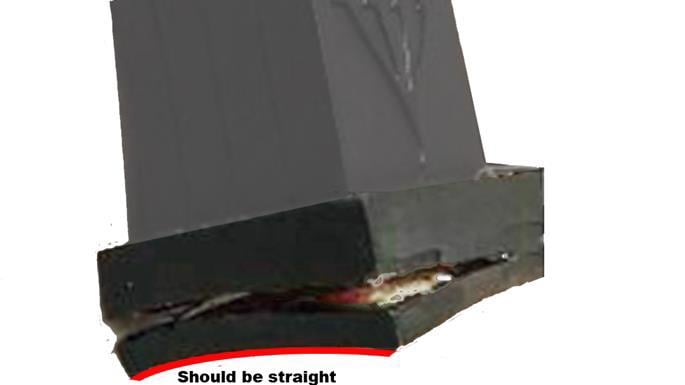
Warped bayit.
The batim are required to maintain a perfectly square shape. A common issue occurs when the bottom of the bayit becomes warped/curved, often due to prolonged exposure to moisture.
Inspection Tips
- If you notice that your bayit is beginning to warp or curve, bring the tefillin to an expert sofer for professional analysis and recommendations.
Prevention Tips
- After showering, ensure that your arm and head are completely dry before donning the tefillin.
- Avoid contact between the tefillin and hair spray, gel or other moisturizing agents.
- If you are prone to significant sweating, take measures to minimize body temperature while wearing tefillin. If this is impossible, speak to your rabbi about reducing the amount of time spent wearing the tefillin.
Additional Recommendations
- When bringing your tefillin to a sofer for a periodic check-up, make sure to specifically request that the sofer check the batim for warping and other potential issues mentioned in this article.
2. Separating Compartments
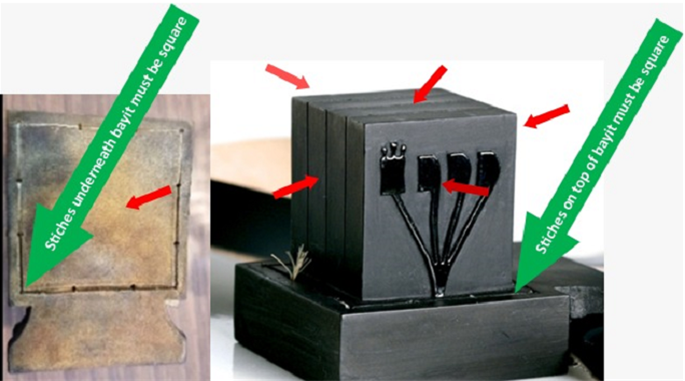
Arrows showing the six sides of a bayit and the stitching (top and bottom) that are all required to be square.
As mentioned, the batim are required to maintain a perfectly square shape. Thus, the length and width of all six sides (see illustration) must match perfectly. The length and width of the stitching on the top and bottom of the bayit must also be square.
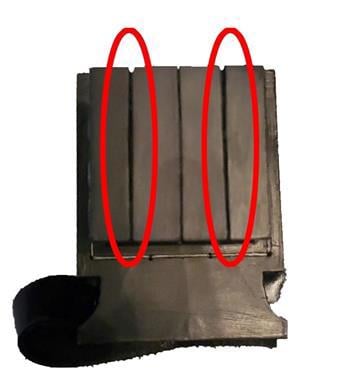
The two outer compartments of this head bayit appear to have begun separating from the two inner compartments.
(The “ma’avarta,” which refers to the part of the base through which the tefillin strap passes, is not included in the measurements for squareness.)
The bayit of the head-tefillin comprises four separate compartments which are pressed strongly against one another to form a perfectly square-shaped box. (Individual parchment scrolls are inserted into each.) These four compartments may sometimes begin separating and spreading apart from one another, ruining the squareness of the bayit.
Inspection Tips
- Sometimes even a one-millimeter difference between the length and width of one of the sides of a bayit can render the tefillin invalid.
- If you can squeeze the compartments closer together by applying gentle pressure with your hand, this means that they have begun to separate.
- If you can recognize growing separation between the compartments with your naked eye, this means that the separation has progressed even further.
- As soon as you suspect a discrepancy in the squareness of a bayit, bring the tefillin to an expert sofer for professional analysis and recommendations.
Prevention Tips
- Avoid leaving the tefillin in a damp environment or in extremely hot or cold temperatures, as this may cause damage to the batim (and/or to the scrolls inside).
- The compartments of the head-tefillin may sometimes be unintentionally separated when a sofer inserts a knife to check the integrity of the compartments. When bringing your tefillin to be checked, it’s recommended to speak with your sofer about this possibility and how it may be avoided.
3. Rounded or Dented Corners
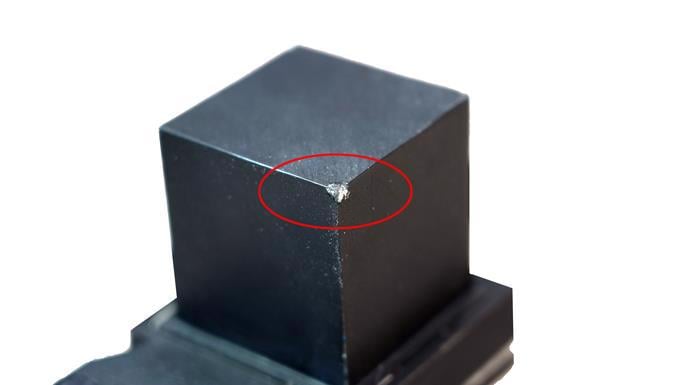
A problem with the corner.
The requirement for the batim to be perfectly square means that each bayit must have 12 perfectly shaped points. These 12 points consist of: a) the four corners at the top of the bayit; b) the four corners at the top of the larger square base upon which the bayit rests; c) the four corners at the bottom of this larger square base. (See accompanying illustrations.)
Note: the base has an area through which the tefillin strap passes. Since that part isn’t considered part of the bayit itself, it isn’t required to be square-shaped or to have properly formed corners. There is no need to inspect the corners of this part of the bayit.
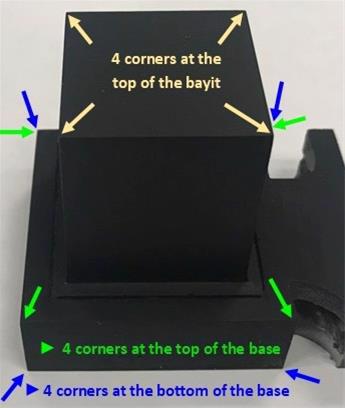
Inspect for 12 perfectly shaped corners.
Inspection Tips
- Inspect the 12 applicable corners of each bayit. If you notice that any of these corners look rounded or chipped, bring the tefillin to an expert sofer for professional analysis and recommendations.
Prevention Tips
- When wrapping up one’s tefillin, replace each bayit into its outer case very gently, to avoid banging the corners against the case.
- It may be helpful to maneuver the bayit into the plastic case while holding the latter stationary, rather than trying to hold the bayit stationary while placing the case around it.
4. Torn Threads
The bayit is sewn together with thread. If these threads are torn, the tefillin may be invalid until repaired.
Inspection Tips
- Inspect the threads. Although the tefillin may still be kosher if only one stitch is severed, if you notice any amount of tearing, bring the tefillin to an expert sofer for professional analysis and recommendations.
5. Peeling or Faded Paint
The top and sides of the batim, and the outward-facing side of the straps, are required to be painted black.
Inspection Tips
- When gaps or faded spots develop in areas that are required to be painted black, you may reinforce the black paint with a certified-for-tefillin “paint pen” or “liquid applicator” that can be obtained at many Judaica stores. Before applying the tefillin paint, be sure to recite the phrase “L’shem kedushat tefillin,” declaring that what you are about to do is for the sake of the sacred mitzvah of tefillin. (Practical tip: tefillin paint may be available in glossy or flat varieties. For aesthetic purposes, try to match the variety with your tefillin’s original paint.
- Tefillin paint must have a special hechsher (certification). Do not use any other coloring instrument to color tefillin.
- If unsure, bring the tefillin to an expert sofer for professional analysis and recommendations.
Prevention Tips
- Avoid wrapping the tefillin very tightly, as this can stretch the strap and lead to the paint cracking.
- Don’t squeeze the tefillin into or against surfaces that could cause the paint to rub off.
- To prevent problems from getting worse, regularly inspect the tefillin paint and touch up gaps or faded areas.
Additional Recommendations
- Sometimes, what appears to be a problem with the paint may actually be an accumulation of hand cream residue, chapstick traces, or other surface deposits. Before painting over apparent cracks in the paint, it may be worthwhile to try gently using a baby wipe or damp cloth to remove any residue from the surface of the tefillin.
6. Narrow Straps

This stretched-out strap is too narrow.
A minimum width (9mm according to the more lenient opinion; 11mm according to the stricter opinion) must be maintained along the entire length of the tefillin straps. If any part of the strap narrows to less than the required minimum, then the tefillin must be brought to a sofer to determine if the entire strap needs to be replaced.
Inspection Tips
- Inspect the straps for narrowing and for tears. Even if the strap appears to be wide but has a tear, the strap may very well be invalid.
Prevention Tips
- Wrapping the tefillin too tightly may cause the strap to stretch lengthwise and to narrow in width.
- Repeated manipulation of the tefillin knot may cause that part of the strap to narrow.
- Tefillin straps become worn over time and weaken with age. Once the straps feel flimsy enough that one could conceivably rip them by hand, it is recommended to have them replaced.

The tear drastically reduces the measurable width of this too-narrow strap even further.
7. Knots
The loop of the head-tefillin strap is formed into a special knot that is positioned at the back of the skull. Similarly, a knot in the arm-tefillin strap is used to secure the tefillin to the upper arm. It is important that [both the front and the back of] these two knots remain in their respective shapes, as they are designed to represent two letters of G‑d’s name. Moreover, the top of the knot of the arm tefillin should not be separated from the bayit.
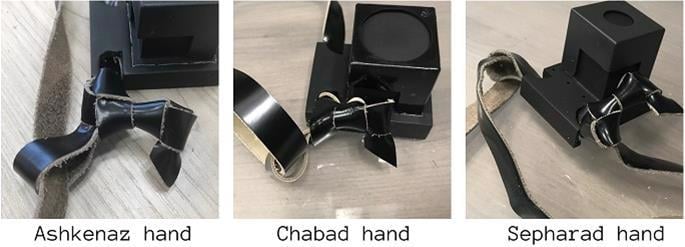
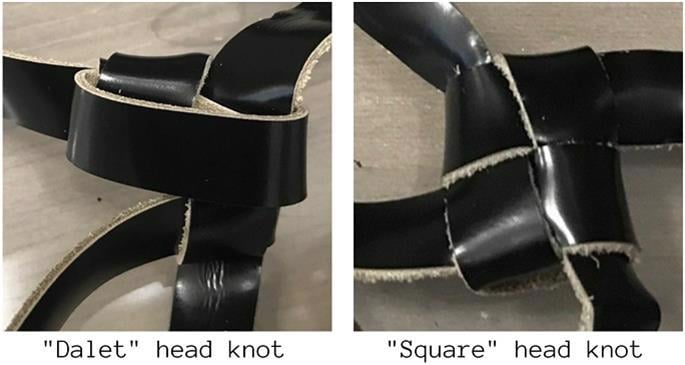
Inspection Tips
- Pay attention to the original shape of your knots and match their designs to the corresponding pictures on this page. When inspecting your tefillin’s knots in the future, make sure that their shape still corresponds to the matching pictures on this page.
- If you’re unsure of the original shape of your knots, and/or if it appears that either of your tefillin knots has lost its original shape, bring the tefillin to an expert who is well versed in how to retie the knots.
- Pay particular attention to ensure that the arm-tefillin’s knot remains in the shape of the letter “Yud,” with a small piece of strap properly extending from the top of the knot (see illustration). It is fairly common for this small piece of strap to lose its proper position, either by becoming “swallowed” into the knot completely, or by becoming too extended from the rest of the knot.
- When wearing the tefillin, make sure that the knot of the arm tefillin is not separated from the arm-tefillin bayit.
Prevention Tips
- Repeated usage, making adjustments to the size/position of the strap, and other regular or irregular handling may cause the knot to loosen and/or change from its original designated shape.
8. Switching
Parts of tefillin that belong to two different classes of holiness may not be switched with one another, in accordance with the rule that, “We may rise in holiness but we may not downgrade in holiness.”1
Example #1: For those who have both Rashi and Rabbeinu Tam tefillin, it is extremely important to avoid mixing up the two sets. Care must be taken not only to ensure that the tefillin themselves aren’t mixed up, but also to avoid mixing up the separate bags or cases that are used for the two sets.
Example #2: Sometimes the hinges of tefillin cases become broken, resulting in the top of the tefillin case becoming completely separated from the bottom. While this in itself doesn’t impact the kosher status of the tefillin, it does give rise to a potential problem whereby the bottom of the arm-tefillin case could now be mixed up with the bottom of the head-tefillin case.
Inspection Tips
- If you suspect that there may have been a mix-up between Rashi and Rabbeinu Tam tefillin, bring the tefillin to a sofer.
Prevention Tips
- To avoid mixing up Rashi and Rabbeinu Tam tefillin (or tefillin bags): Ensure that one set of tefillin is completely wrapped up and put away in its marked cases and bag before removing the other set of tefillin from its own marked bag and cases.
- Tefillin batim may not be marked in any way to differentiate between Rashi and Rabbeinu Tam. With regard to making a differentiation by marking the straps in some way, consult a Rabbi first to confirm that the marking method is permitted.
- To avoid the problem of mixing up the bottom half of broken tefillin cases, affix a sticker or otherwise clearly mark the bottom of each broken tefillin case. Alternatively, simply purchase a set of new cases
PLEASE NOTE: This article presents a brief summary of some of the most common problems that can arise with regard to the outside of the tefillin batim and straps.
Checking the scrolls that are placed inside the tefillinfor mistakes and/or deterioration involves much more skilled analysis, and may only be done by a trained, certified scribe. This type of inspection is beyond the scope of this article.
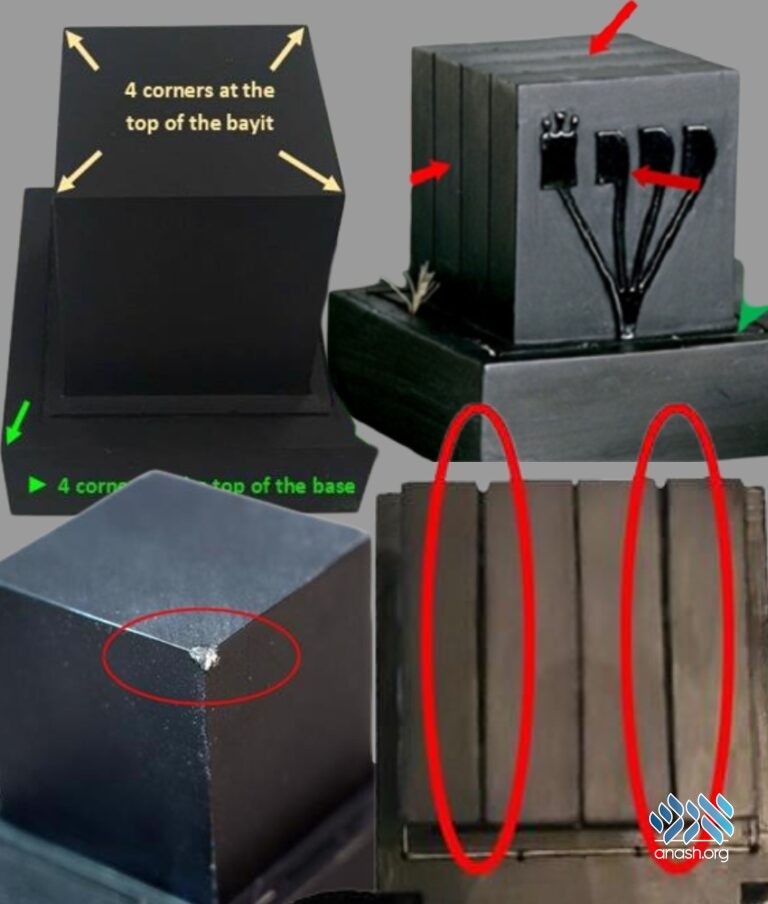
About # 2:
עי’ סי’ ל”ב פתחי תשובה ס”ק נ”ח, וכן פסק הרב זלמן שמעון ז”ל דווארקין למעשה.
Correction to the previous comment :
שערי תשובה
Not פתחי תשובה